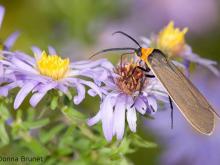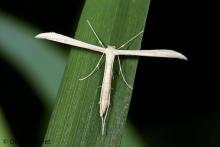Land Invertebrates
Media

Species Types
Scientific Name
Lucanus elaphus
Description
The giant stag beetle is enormous, the males reaching 1½ inches in length without the mandibles, and nearly 2½ with them. Look for them on rotting logs in forests in early summer. They’re also attracted to lights.
Media

Species Types
Scientific Name
Cinindela sexguttata
Description
The six-spotted tiger beetle is probably the most familiar tiger beetle in Missouri. It’s most often seen in spring, as it darts in and out of trails just ahead of hikers.
Media

Species Types
Scientific Name
Cinindela repanda
Description
The bronzed tiger beetle is usually seen patrolling the shores of creeks, rivers, and other bodies of water, in open areas with sand, gravel, or clay soils.
Media

Species Types
Scientific Name
Lixus concavus
Description
The rhubarb weevil has a dusty, bright yellow coating and feeds on rhubarb, dock, thistles, and other plants in the smartweed or buckwheat and sunflower families.
Media

Species Types
Scientific Name
Curculio spp.
Description
Nut and acorn weevils, in genus Curculio, have very long, narrow beaks and chunky bodies. Females bore tiny holes into developing acorn, hickory, or other nuts, and deposit their eggs within.
Media

Species Types
Scientific Name
Rhodobaenus quinquepunctatus
Description
The cocklebur weevil is about ¼ to ½ inch long. The larvae bore inside the stems and roots of cocklebur, ragweed, and other plants in the sunflower family.
Media

Species Types
Scientific Name
More than 40 species in 3 genera in North America north of Mexico
Description
Ebony bugs are definitely true bugs, but they look a lot like tiny, shiny black beetles. Their bodies are fat ovals. They’re almost always seen on flower clusters and immature seeds, often on members of the carrot or parsley family.
Media

Species Types
Scientific Name
Cicindela limbalis
Description
The common claybank tiger beetle, or green-margined tiger beetle, occurs on dirt clay soils in open areas in spring and, less abundantly, in late summer. Color varies from red to purple to green. The outer shell edges are often edged with shiny green.
Media

Species Types
Scientific Name
About 120 species in North America north of Mexico
Description
Fungus weevils are a family of beetles that differ from other weevils by their broad, flat bills and clubbed, but not elbowed, antennae. It's a diverse group, but many do feed on bracket mushrooms and other fungi.
Media

Species Types
Scientific Name
More than 4,400 species in North America north of Mexico
Description
Rove beetles usually have very short wing covers, so several of their hind abdominal segments are exposed. Typically fast movers, they often flip up their abdomen tips when frightened. This is a huge family of beetles.
See Also



Media

Species Types
Scientific Name
Cisseps fulvicollis
Description
The yellow-collared scape moth is more often “orange-collared.” And whether you think it looks more like a firefly or a wasp, it’s still a moth!
Media

Species Types
Scientific Name
Nearly 150 species in North America north of Mexico
Description
Slim, delicate plume moths are instantly recognizable by their T-shaped silhouette, long legs, and muted shades of tan and brown. It can be hard to separate the various species.
Media

Species Types
Scientific Name
Pyrrharctia isabella
Description
Not many people know the adult Isabella tiger moth when they see one, but we’re all acquainted with its caterpillar, the woolly worm, or woolly bear.
About Land Invertebrates in Missouri
Invertebrates are animals without backbones, including earthworms, slugs, snails, and arthropods. Arthropods—invertebrates with “jointed legs” — are a group of invertebrates that includes crayfish, shrimp, millipedes, centipedes, mites, spiders, and insects. There may be as many as 10 million species of insects alive on earth today, and they probably constitute more than 90 percent all animal species.





















